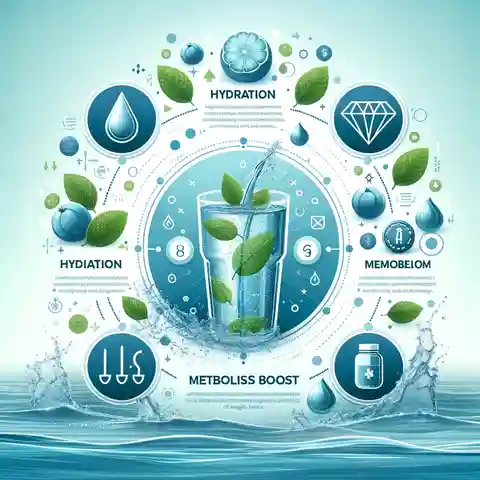Sometimes, people need extra help to get healthy, and that’s where blood transfusions come in. A blood transfusion, which is the infusion of blood from one person to another, can help with serious blood loss, anemia, diseases, and more!
What is a Blood Transfusion?

Infusion of Blood from One Person to Another – A medical illustration showing a male patient receiving a blood transfusion in a hospital setting
Imagine you’re feeling weak and tired. Maybe you get winded easily or just can’t seem to keep up with your friends. It could be a sign that your body needs a helping hand. That’s where a blood transfusion comes in!
A blood transfusion is when a doctor gives you blood from another healthy person. Think of it like a special kind of pick-me-up for your blood. The donated blood is carefully checked to make sure it’s safe for you and is delivered through a thin tube into your vein, kind of like an IV.
Why Would Someone Need a Blood Transfusion?
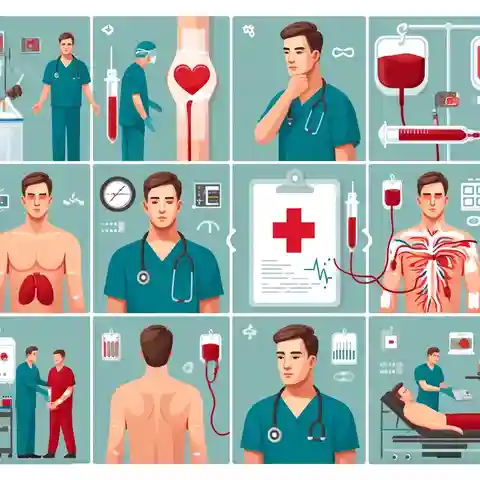
Infusion of Blood from One Person to Another – Various scenarios where a male patient might require a blood transfusion, such as after a traumatic
But why would you need someone else’s blood? There are a few reasons:
- Blood Loss: If you’ve been in an accident or had major surgery, you might lose too much blood. A transfusion can replace what’s missing and help you get strong again.
- Low Red Blood Cells: Red blood cells carry oxygen throughout your body. If you don’t have enough (a condition called anemia), you’ll feel tired and weak. Transfusions can boost your red blood cell count and give you more energy.
- Fighting Illness: Some diseases like sickle cell anemia or bleeding disorders can make your blood work incorrectly. Transfusions can help your blood do its job of clotting and carrying oxygen properly.
- Other Treatments: Sometimes, people undergoing cancer treatment or organ transplants might need transfusions too.
Blood transfusions are a safe and effective way to help people in need. They can be lifesavers!
Different types of blood transfusions
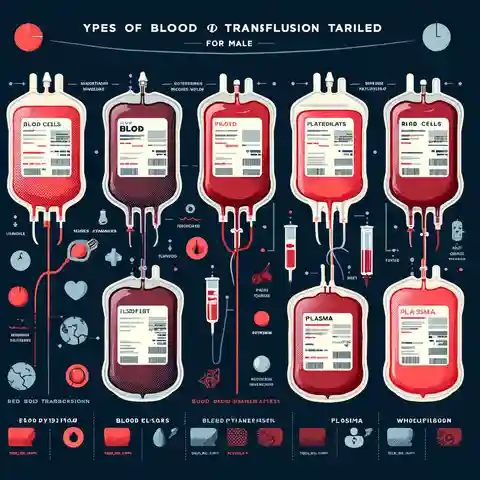
Infusion of Blood from One Person to Another – A detailed visual comparison of different types of blood transfusions
Blood transfusions aren’t a one-size-fits-all deal. Here’s what you might get:
- Red Blood Cell Boost: The most common one! Think of it as extra energy for your blood if you’re anemic or have lost blood.
- Platelet Power-Up: These tiny helpers stop bleeding. People with low platelet counts or bleeding problems sometimes need this kind of transfusion.
- Plasma to the Rescue: This liquid carries important things around your body. If you have blood clotting issues, a plasma transfusion could be the answer.
- Rare, but Important: Whole blood transfusions have everything in them. Doctors usually only use them after major blood loss.
Keeping it Safe: Blood Types and Testing Matter!
Blood isn’t the same for everyone! We have different blood types (A, B, AB, and O). The right match is key for a safe transfusion. Doctors do tests to make sure everything’s good to go.
- The Type Test: A simple test tells doctors what type of blood you can get.
- Avoiding Trouble: The wrong blood type can cause problems! That’s why blood type matching is a big deal for safety.
- Disease Detective: Donated blood gets tons of tests to look for things like hepatitis or HIV. This careful testing is important!
- Top Priority: Hospitals and blood banks are super careful about keeping donated blood safe.
The Process of Donating Blood: Infusion of Blood from One Person to Another
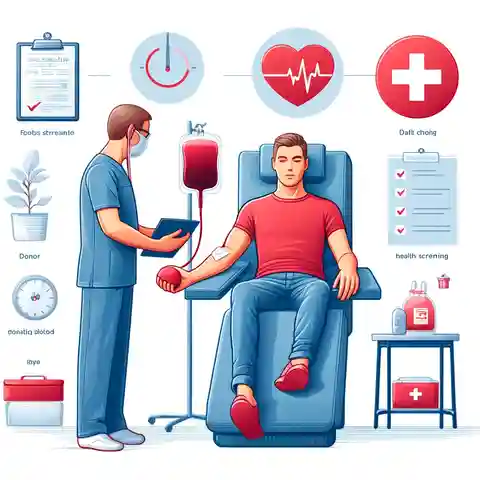
Infusion of Blood from One Person to Another- An image showing a male donor going through the steps of donating blood
If you’re healthy and old enough, it’s definitely something to think about. Here’s how it works:
Step 1: Are You Ready?
- The Basics: Most places need you to be at least 17 (or 16 with a parent saying it’s okay), weigh enough, and feel good that day.
- Quick Questions: They’ll ask about your health, where you’ve traveled, and any medicine you take. This is all about making sure your blood is safe to give to someone else.
- Little Check-Up: They’ll take your blood pressure, temperature, and do a tiny finger prick to check your iron.
Step 2: Time to Donate!
- Get Comfy: You’ll chill in a reclining chair – think dentist’s office, but nicer!
- Tiny Pinch: A nurse cleans your arm and puts in a new needle. Might feel a little ouchy, but it’s quick.
- Hang Out: It takes around 8-10 minutes to get a pint of blood. You can chat, read, whatever helps pass the time.
- Snacks!: Afterwards, it’s juice, cookies, and a little time to relax and make sure you’re good to go.
Step 3: Your Blood Helps Others
- Testing Time: They check your blood for diseases, then separate it into different parts to help more people.
- Saving Lives: Your blood could help someone in surgery, with cancer, or who’s been hurt in an accident!
Donating blood is safe, simple, and feels amazing knowing you’ve helped someone.
What are the Risks of a Blood Transfusion?
Understanding these is important so you can make informed decisions about your health.
Common Reactions
- Fever and Chills: They often feel like a mild flu and usually go away alone or with simple treatment.
- Itchiness or Minor Rash: Sometimes, Medication like antihistamines can assist in managing these responses.
Less Common, But More Serious
- Transfusion-Related Lung Injury: This rare complication can cause it more difficult to breathe. Doctors carefully monitor for it and can provide treatment if it happens.
- Infections: Donated blood is rigorously tested for conditions like hepatitis or HIV, making the possibility of getting sick from a transfusion low.
- Delayed Reactions: In some cases, issues can appear days or weeks behind a transfusion, like new conditions or a study of red blood cells.
Minimizing the Risks
- It’s All About Safety: Blood banks and hospitals follow strict rules to keep transfusions safe. Donated blood undergoes multiple tests and careful handling every step of the way.
- Close Monitoring: Nurses will watch you for reactions during your transfusion. This is why telling them immediately is important if you feel anything unusual.
If you’re recommended for a transfusion, discuss the benefits and the potential risks with your doctor. They can give you more specific information based on your individual health needs.
Alternatives to blood transfusions
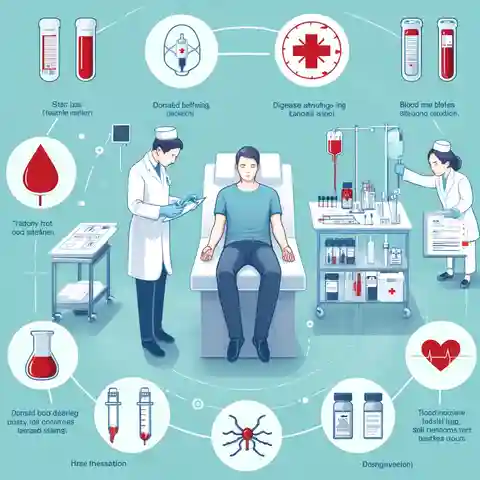
Infusion of Blood from One Person to Another – An image illustrating the safety protocols followed during the blood transfusion process
Websites like the Red Cross have tons of great information about blood donation and transfusions. Your doctor can also answer any questions you have.
Blood transfusions save lives, but sometimes there are other options doctors can try. Here’s a look at some of those:
Fixing What’s Causing the Problem
- Need More Iron? If you don’t have enough red blood cells because of low iron, special pills or eating more iron-rich foods can help instead of a transfusion.
- Missing Vitamins: Not enough of certain vitamins can also make you anemic. Vitamin supplements or a change in what you eat can fix this.
- Medicine to the Rescue: Some medicines make your body create more red blood cells on its own.
Losing Less Blood
- Planning Ahead: Before surgery, doctors can sometimes give you medicine to help prevent a lot of bleeding.
- Special Techniques: Some types of surgery are done in ways that help you lose less blood.
- Recycling Your Blood: During some operations, a cool machine can collect the blood you lose and clean it so you can get it back!
Not Quite the Same: Lab-Made Blood
- Oxygen Experiments: Scientists are trying to make things that carry oxygen in your body like red blood cells do. This is still being tested and isn’t common yet.
- When You Just Need Volume: If you lose a lot of fluids, doctors can give you something like super-salty water, but it’s only a temporary fix.
Why It Matters
- What’s the Big Problem? Doctors choose the best treatment based on why you might need a transfusion.
- Your Choice: Some people don’t want transfusions because of their beliefs. Doctors try to respect this while still making sure you get the care you need.
- Science is Cool: Researchers are always working on new ways to keep people healthy!
If a doctor suggests a blood transfusion, ask about other options and what might be safest or best for you.
How Long Does a Blood Transfusion Take?
The short answer is, it takes a while! Here’s what you need to know:
- Type Matters: Red blood cells are what most people get, and that takes 1-4 hours. Platelets or plasma transfusions can be quicker – think around 30 minutes to an hour.
- It Adds Up: The more blood you need, the longer it’ll take. Makes sense, doesn’t it? Doctors decide the exact amount for your situation.
- Safety First: Nurses don’t rush this! They start slow and keep an eye on you for any reactions. It’s a little longer, but way safer.
- Break Time: Sometimes they might pause for a few minutes, just to be extra sure everything’s going smoothly.
Most blood transfusions take a few hours. Might not be the most exciting way to spend your day, but hey, it’s definitely important!
FAQs
Am I eligible to donate blood?
Eligibility depends on factors like age, weight, health, and travel history.
How long does it take to recover after donating blood?
Most people feel back to normal within a day or two. Drinking plenty of fluids and resting helps your body replace the donated blood quickly.
Are there any long-term side effects of getting a blood transfusion?
Most people don’t experience lasting side effects. In rare cases, delayed reactions might occur weeks later, so it’s important to tell your doctor if you don’t feel well after a transfusion.
Can I refuse a blood transfusion?
You generally have the right to refuse medical treatment. Talk to your doctor about the potential risks of refusal and if there are alternative treatments suitable for your situation.
Want to find out more?
Websites like the Red Cross (https://www.redcrossblood.org/) have tons of info about donating blood!
Let’s Recap!
Blood transfusions are amazing ways to help people who are sick or hurt. It’s important to understand how they work and why they’re sometimes the best way to make someone feel better. If you’re eligible, consider donating blood – you could help save a life!

